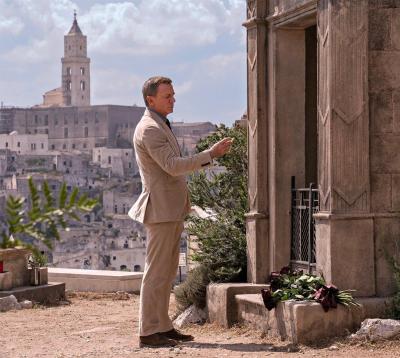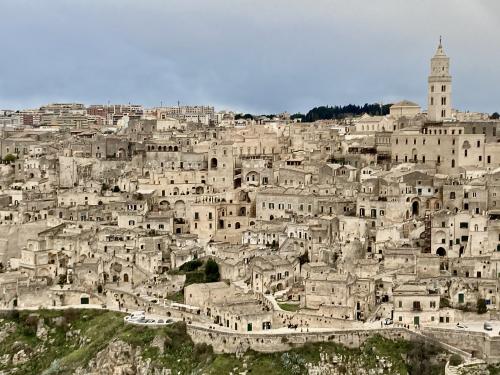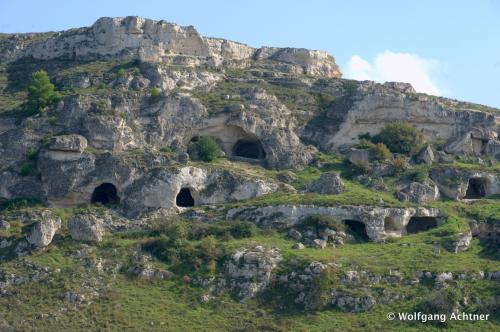A close-up view of Matera

A small town in the southern Italian region of Basilicata, catapulted into the limelight by the latest James Bond film, “No Time To Die’
With business slowly improving after the restrictions imposed by the Covid-19 pandemic, the locals in Matera are awaiting to reap the benefits that experts are predicting due to the important role the Southern Italian city has played in “No Time To Die,” the 25th film in the James Bond franchise, featuring for the first 18 minutes before the opening credits.
Matera was the European Capital of Culture in 2019 and is rightfully enjoying its current moment in the limelight. According to the tenth edition of the Traveller Review Awards compiled by Booking.com based on over 232 million verified reviews from real travellers, it's just been recognized as Booking.com's #1 Most Welcoming City in the world for 2022.
Matera, is divided into two separate areas, a new and an old city, the most interesting of which is the latter called “i Sassi,” “the Stones,” divided into two separate districts. The Sasso Barisano is located on the inside of the old city centre, and forms a sort of bowl, descending from Piazza Vittorio Veneto to the Rione Vetera and rising up again to the Piazza del Duomo.
The Sasso Caveoso is located on an outward facing slope, descending from the Duomo until roughly the halfway mark along the steep ravine dug by the Torrente (stream) Gravina that separates the city from the troglodyte dwellings clustered near the top of a cliff facing Matera, on the opposite side.
Across the ravine, grottoes blanket the landscape, and were the first homes to settlers before it occurred to them to dig.
In most “normal” cities, houses are built on a more or less flat surface and are clustered together in a way that those closest to the viewer block out the view of the ones behind them.
Instead, a particular feature of the Sassi is that all the dwellings are built on the steep slope of a hillside, many of them extensions of caves dug sideways into the limestone of which the hills are made, with the buildings piled up on top of each other – the roof of one house can be the floor of another – and laid out along a labyrinthine maze of streets, narrow passages and stairways that allows every house to be visible, as it faces out onto the void in front of it. Matera greatly resembles a cityscape drawn by the Dutch artist Maurits Cornelis Escher, where the passages and staircases are connected to one another in a single infinite loop.
Due to Matera’s location above a deep ravine that divides the territory into two areas, it was almost impossible for residents to obtain water from the river below, especially in the hot, dry summers when the water levels were low. So early dwellers built an elaborate system of underground cisterns that were used to collect rainwater and subsequently provide a year-round water supply to residents.
Excavations surrounding Matera provide evidence of human occupation from the early Palaeolithic Age, roughly 15,000 B.C., when the last Ice Age was about to end and woolly mammoths roamed the earth. What makes Matera different from other Palaeolithic settlements, though, is that those inhabitants, and their ancestors, never left.
In the Bronze and Iron and Ages, newly-equipped with metal tools, settlers dug underground caverns, cisterns, tombs and dwellings in the landscape’s soft limestone called tufa. Those people remained in Matera throughout the centuries and successive ages of rulers and empires, from Greeks to Romans to Byzantines and their descendants are still there today.
Beyond the Sassi, Matera also grew on the hilltop. In the 17th century, the city expanded to cover the plateau, and a separation between the two areas widened. While the top part was inhabited by landowners, merchants and local administrators from the ruling Kingdom of Naples, the Sassi were home for the poor masses and, eventually, they came to symbolize southern Italy's extreme overcrowding and extreme poverty.
Indeed, one may find it surprising to learn that Matera was once one of the poorest cities in Europe. Unknown to most Italians, the city concealed a society living in poverty and degradation. As recently as the 1950s, more than half of the Matera’s population (20,000 people) lived in grottoes that were originally intended as animal stalls. Families with an average of six children shared a single cave dwelling with dogs, sheep, goats and pigs. Malaria was rife and infant mortality rates were as high as 50%.
Between 1935 and 1936, Italian artist, painter and author, Carlo Levi, was exiled to the village of Aliano, Basilicata (also known as Lucania in the 1930s), located some 90 kilometres from Matera, on account of his involvement with anti-fascist organizations.
Matera’s obscurity ended in 1945, when Levi published his memoir Christ Stopped at Eboli, about his year of political exile in Basilicata during the Fascist regime. His sister Luisa, also a trained doctor, stopped in Matera on her way to visit him and was responsible for calling his attention to the plight of its residents.
Levi painted a vivid portrait of a forgotten rural world that had sunk into a desperate poverty since the unification of Italy in 1870. The book’s title, referring to the town of Eboli near Naples, suggested that Christianity and civilization had stopped just on the outskirts of Naples, never reaching the deep south, leaving it a pagan, lawless land, where some believed shepherds lived with wolves.
Levi singled out the Sassi for their “tragic beauty” and described them “like a schoolboy’s idea of Dante’s Inferno,” The town’s prehistoric cave dwellings had by then become “dark holes” riddled with filth and disease, where barnyard animals were kept in dank corners, chickens ran across the dining room tables, and infant mortality rates were horrendous, on account of widespread malaria and dysentery.
“In these dark holes I saw a few pieces of miserable furniture, beds and some ragged clothes hanging up to dry. On the floor lay dogs, sheep, goats and pigs… Children appeared from everywhere, in the dust and heat, stark naked or in rags, eyelids red and swollen… and with the wizened faces of old men, yellow and worn with malaria, their bodies reduced by starvation to skeletons… I have never in all my life seen such a picture of poverty.” — Carlo Levi
Levi’s book caused a pandemonium in post-war Italy, and the Sassi became notorious as la vergogna nazionale, the disgrace of the nation. After a visit in 1950, Italian Prime Minister and head of the Christian Democrats, Alcide De Gasperi, was so appalled that he set in motion a draconian plan to relocate the Sassi’s entire population to new housing developments. After his visit to the Sassi, De Gasperi declared that “this sad remnant of past centuries should disappear.” Two years later, the government passed the first bill for the risanamento, or clean-up, of the Sassi. Materans living in the worst caves would be moved; the more habitable grotte would be renovated.
De Gasperi's government passed laws to establish modern neighbourhoods on the outskirts of Matera, far away from the cave homes. Some 3,000 Sassi, stretching across 74 acres, had housed 20,000 people. In 1953, the first families were transferred to newly built districts, and by 1970 their exodus was complete. With the new neighbourhoods located within Matera's periphery, the city grew more than 11 times in size. Italy's top architects were invited to create the new housing complexes, and they designed starkly modernistic alternatives to the swarm of ancient caves.
Now abandoned, the Sassi became a ghost town of deserted homes, vagrants and prowling packs of wolves, with many relocated residents too ashamed to ever set foot back on the weed-covered streets of their inhumane past.
By the 1970s, the Sassi were completely empty. Everything was covered in vegetation and trash like the site of a long-lost abandoned city in a tropical forest. There were discarded old fridges and washing machines everywhere. Nobody was interested in cleaning up the area, let alone renovating it and promoting it. Some inhabitants even went as far as to propose burying the Sassi under layers of cement.
Today, the Sassi are about 40 per cent re-inhabited. Many are homes to members of Matera's artistic community. New laws passed in 1986 have helped underwrite restoration, and cadres of builders and designers have contributed to revitalizing the area.
The first townsmen started returning in the 1990s, and they weren’t poor families but well-to-do professionals: doctors, engineers and architects. The Sassi became the “in” area, the most glamorous of the entire town. Some cave dwellings were renovated to become cafes and boutique hotels.
Modern homes, carved into rock but outfitted with all the expected amenities, lead to cavernous rooms and some cisterns have been transformed into small swimming pools. There are about 2,000 inhabitants in the Sassi today. Along with cave hotels, there are now cave restaurants, cave cafés, cave art galleries and cave clubs.
Known as la città sotterranea ("the underground city"), in 1993 the Sassi and the park of the Rupestrian Churches were named a UNESCO World Heritage Site. In 2019, Matera was declared a European Capital of Culture.
Compared to other well-known Italian cities like Florence, Venice or Rome, Matera can be considered a relative “new entry” as an international tourist destination. The city of the Sassi has been growing rapidly as a tourist area. Just 7 years ago, there were some 300 places (Hotels and B&Bs) where one could stay in Matera and now there are roughly one thousand.
I’m happy to have visited Matera several times before the city was discovered by the whole world. Increasingly popular on account of its unique beauty with Italian tourists for the last decade, until recently this ancient city had remained relatively unknown to foreign visitors, especially Americans. In the next few years, that is certain to change especially after the release of No Time To Die, last September. I would advise a visit to this inimitable city as soon as possible and before it becomes engulfed by mass tourism that has devastated many beloved tourist destinations around the world.
What to visit in Matera:
Matera’s old town: la città vecchia has a network of streets, tunnels and alleys that intertwine in such a beautiful and wonderful way that the city was declared a World Heritage Site by UNESCO in 1993. In the Sasso Caveoso area of the city you can find the original cave houses still intact, while in the Sasso Barisano you can visit the workshops of artisan craftsmen.
The Cathedralof the Madonna della Bruna and Sant’Eustachio is the Cathedral of Matera, dedicated to the Virgin Mary, the patron saint of the city, and to the Christian martyr Saint Eustace. With its impressive bell tower, Romanesque facade and a beautiful stained-glass window, the church is located on the highest point of the old city, between the two Sassi, the ancient districts of Matera.
Rupestrian churches One of Matera’s most unforgettable sights is its chiese rupestri or rock churches, that are full of ancient frescoes. In addition to several important ones located in the Sassi, there are another 150 in the Park of the Rock Churchesacross the Gravina stream. Dating back to the 12th century, the Chiesa di San Pietro Barisanois the largest among those located in the Sassi, its interiors completely carved out of the rock. St. Peter's is built over a cave complex that served as a repository for the dead. There are beautiful frescoes from the 15th century upon entering the church, representing several saints and the Annunciation. Other important rock churches include Santa Maria de Idrisand the Church of Santa Lucia alle Malve, which are located side by side in a highly spectacular spot on top of a rocky spur.The most famous is the former, also known as Madonna de Idris, a small church carved into the limestone cliff looming over the Sasso Caveoso. Inside, there is a single nave with frescoes that date back to the 12th century and are in very poor condition. Santa Lucia alle Malve dates back to the 8th century, when it was built adjacent to a monastery of Benedictine nuns. This rupestrian church has a number of 13th-century frescoes, including an unusual breastfeeding Madonna.
Palombaro lungo Hidden beneath, Piazza Vittorio Veneto, Matera’s main square, is an enormous 16-metre deep underground water cistern called Palombaro Lungo that was dug in the 1800s and supplied the townspeople with water until the 1960s. Due to Matera’s location above a deep ravine beneath a steep hill that divided the territory into two areas, it was almost impossible for residents to obtain water from the stream below, especially during the summers when the water levels were lower than usual. So early dwellers learned to build a series of underground cisterns that would collect rainwater and subsequently provide a year-round water supply to residents. Palombaro Lungo was only rediscovered and excavated as recently as 1991.
MuseumsMatera has several museums that are worth visiting, including the Archaeological Museum, with a collection of 4th- and 5th-century Greek vases, and the Museum of Medieval and Modern Art, housed inside Palazzo Lanfranchi. Amongst the permanent exhibitions, there is a selection of regional religious works from the 12th to the 18th centuries, along with some statues in wood, in polychrome stone and papier-mâché. There are also paintings by local mannerists, and a collection of works consisting of 199 paintings and a sculpture by writer and painter from Turin, Carlo Levi, owned by the Carlo Levi Cultural Foundation in Rome. This collection includes the famous mural "Lucania '61", the canvas that Carlo Levi painted to describe the Basilicata region and to honour his Lucanian friend, Rocco Scotellaro. This artwork represents the life of the poet Rocco Scotellaro in three fundamental moments: in the centre, adolescent Scotellaro; on the right, adult Scotellaro, in Piazza Tricarico; on the left, Scotellaro lies deceased in a cave, with a group of people afflicted by the loss. The scenes represent Lucanian everyday life in 1960, and many of them are directly inspired by photos by Mario Carbone. Also worth a visit, Musma, the Museum of Contemporary Sculpture, the biggest Italian museum dedicated to sculpture, with works by Cambellotti, Cascella, Consagra, Del Pezzo, Matta and others, housed in centuries-old caves below ground and in a 16th-century palace above.
View of MateraThe best view of Matera is from the Belvedere on top of the plateau across the Gravina, in the Parco Regionale della Murgia Materana.
In the footsteps of James Bond in Matera
For those interested in visiting the locations of the main chase scenes in the sequence filmed in Matera of “No Time To Die,” they are as follows: Via Gradoni del Duomo and Piazza Duomo where the motorcycle jump scene was filmed, whereas the car chase took place along Via Madonna Delle Virtù, a walled perimeter road that runs along the North East edge of the town with stone buildings on the West side and a steep drop to the Gravina ravine to the East, and Piazza San Giovanni Battista where Bond performs a series of doughnuts with the DB5 and manages to escape the bad guys from Spectre using the on-board machine guns and smoke machine.
Madeleine and Bond’s hotel room was constructed in the Piazzetta Pascoli area.
The cemetery was located near the church of Madonna delle Vergini in Murgecchia close to the Belvedere facing the town.


© COPYRIGHT ITALIAN INSIDER
UNAUTHORISED REPRODUCTION FORBIDDEN


